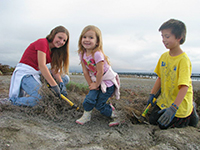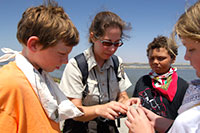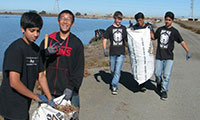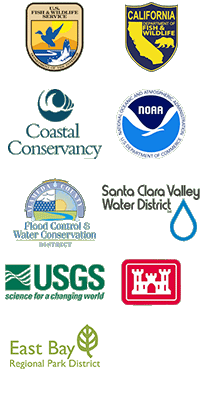| Email not displaying correctly? View it in your browser. |
 |
|
August 2013 Newsletter
Volume 31  More events, including volunteer restoration opportunities, are listed on the Events and Meetings section of the project web site. Annual Joint Stakeholder Forum & Working Groups Meeting San Jose Santa Clara Water Pollution Control Plant, Alviso Tuesday, September 24 Walking Tour, Ponds A16/A17: 11:00 a.m.-12:15 p.m. Meeting: 1:00-3:45 p.m Mark your calendar for the annual meeting for South Bay Salt Pond stakeholders and the public. This year, we will hold a tour of our recently completed construction at Ponds A16 & A17, where we built nesting islands and a fish screen and opened 130 acres to the Bay. The meeting will include discussion of potential Phase 2 projects at Eden Landing, and the latest science and flood management planning news. We will send out further information about the workshop as the agenda is developed, or check back on the project website Events and Meetings page. Public Scoping Meeting Environmental Impact Analysis for Phase 2 Actions at Alviso & Ravenswood Ponds Tuesday, September 24 4:00-6:00 p.m. San Jose Santa Clara Water Pollution Control Plant, Alviso Provide your thoughts on what the environmental impact analysis for potential Phase 2 actions at the Alviso and Ravenswood ponds should include. The meeting will be held shortly after our annual Stakeholder Forum & Working Groups meetings. We will send out further information as the agenda is developed, or check back on the project website Events and Meetings page. September 2013 Tend the Gardens of Eden Landing Ecological Reserve Saturday, September 7 Eden Landing Ecological Reserve, Hayward 9:00 a.m.-12:00 p.m. The vibrant and fragile plants and wildlife living in Eden Landing need a hand, You can make a difference when you help remove invasive plants and trash. The endangered salt marsh harvest mouse, steelhead trout, and starry flounder don't know what they'd do with you. Come learn about the exciting changes happening in your Bay. To register or for more information: Tend The Gardens of Eden Landing Ecological Reserve (Hayward/Union City). 
Why Tides Matter Sunday, September 8 Environmental Education Center, Alviso 10:00 a.m. - 11:00 a.m. Docent Laurel Stell will talk and walk you through all things tides. What are they? How do they affect wildlife? How have humans reshaped the Bay's tidal lands? Program starts indoors but will move outside for an easy 0.5-mile walk. All are welcome. For any questions please contact Jose at Call (573) 231- 6190. Going Green, the Restoration of the South Bay Salt Ponds Saturday, September 21 Environmental Education Center, Alviso 10:00 a.m. - 11:00 a.m. Join an interpretive walk to photograph the wildlife and wetlands in the South Bay Salt Pond Restoration Project. Learn and be a part of the history of the wetland restorations, and how knowing the area will both increase your appreciation for it and ability to see it in whole new way. Know what plants or animals you will see in which habitat, and at what times. Digital or film welcome. Led by Park Ranger Joseph Garcia. Call (573) 231- 6190 for reservations. The Basic's of Salt Pond Restoration Saturday, September 28 Environmental Education Center, Alviso 2:00 p.m. - 3:30 p.m. Find out about the salt pond restoration project with Jose Garcia, park ranger at Don Edwards San Francisco bay National Wildlife Refuge. This ambitious seeks to restore 15,100 acres of former industrial salt ponds to their original natural state. Illustrated, and interactive talk will be in the Environmental Education Center's auditorium and, if weather permits, will include a walk on the .25-mile boardwalk trail to view the progress thus far. For any questions please contact Jose at Call (573) 231- 6190. National Estuaries Day at the Ravenswood Salt Ponds Saturday, September 28 Ravenswood Ponds, Menlo Park 9:00 am - 12:00 pm Join Save The Bay out in the marsh at the Ravenswood Salt Ponds on National Estuaries Day. Did you know that San Francisco Bay is actually an estuary? Have you ever heard of brackish water? Do you know how many major estuaries can be found in the United States? Save The Bay's field educators are estuary experts and after spending a day on the Bay with them, you will be too. To register, see National Estuaries Day at the Ravenswood Salt Ponds (Menlo Park).  October 2013 What are the wetlands? (a class for all ages) Saturday, October 12 1:00 p.m. - 2:00 p.m. Fossils and Flumes help to teach children about the South Bay Salt Ponds Restoration Project. Park Ranger Jose Garcia brings fossils from Triassic wetlands he collected in eastern Montana, to show the similarities to wetlands today, and explain their function in nature. Interactive flumes allow for a hands-on experience of how the wetlands protect the surrounding area from flooding. An adult must accompany children Call (573) 231- 6190 for reservations. November 2013 The Basic's of Salt Pond Restoration Saturday, November 16 Environmental Education Center, Alviso 2:00 p.m. - 3:30 p.m. Find out about the salt pond restoration project with Jose Garcia, park ranger at Don Edwards San Francisco bay National Wildlife Refuge. This ambitious project seeks to restore 15,100 acres of former industrial salt ponds to their original natural state. Illustrated and interactive talk will be in the Environmental Education Center's auditorium, and, if weather permits, will include a walk on the .25-mile boardwalk trail to view the progress thus far. For any questions, please contact Jose at (573) 231- 6190. Give Back to the Bay at Eden Landing Ecological Reserve Saturday, November 23 Eden Landing, Hayward/Union City 9:00 a.m. - 12:00 p.m. Give thanks to the Bay by planting native seedlings along the shoreline! You can help us reach our goal of 30,000 native seedlings planted this season. Your work has a direct impact. It will increase habitat for endangered birds and wildlife such as the salt marsh harvest mouse and the California clapper rail, and help improve the Bay's water quality. Other activities include mulching, watering, and shoreline clean-up. To reserve a space, see Give Back to the Bay at Eden Landing Ecological Reserve (Hayward/Union City). Bird Migration Walk Saturday, November 30 Ravenswood Pond SF2, Menlo Park 1:00 p.m.- 2:30 p.m. Our wetlands are an important stop on the Pacific Flyway, a major bird migration route. Stroll with docent Laurel Stell to learn why the birds migrate, why they stop along the San Francisco Bay, and to spot the birds in action. Trail is easy and level. All ages and abilities welcome. Meet at the SF2 trail parking area on the west side of the Dumbarton Bridge. For information and directions, please call (573) 231- 6190. Reservations requested. 
Become a Friend of the Salt Ponds on Facebook Want to receive regular updates, interesting trivia and the latest pictures and videos about the South Bay Salt Pond Restoration? Join us on Facebook. Photo Credits: Rob Holt, Judy Irving, Ben Young Landis, George Ramos, Save The Bay For a complete list of our partners, major donors and participants, see here. 
|
Symposium Draws 200 to Learn, Share Ideas on Science

The Project's July biennial Science Symposium brought together about 200 scientists, agency representatives and interested members of the public for a day of information-sharing and dialogue. The event at the USGS campus in Menlo Park was capped by an hors d'oeuvre- and cake-filled poster viewing and celebration of the Project's 10th anniversary. Scientists shared insights, slides and posters on key restoration science issues, including the results of mercury monitoring, how fast restoration areas are building mudflat, and what kinds of islands seem to succeed best at attracting birds to nest and hang out. Plenty of ideas and information were also shared informally, in the hallways and at the refreshments tables. One such conversation produced media coverage on UC Davis fish researcher Jim Hobbs' news that salt pond habitat improvements have attracted enough prey creatures to draw high numbers of leopard sharks to feast on the burgeoning wildlife. (See below for a news article and TV news video.) 
The $6.5 million cost of construction for Pond A16 and neighboring Pond A17, which was opened to the Bay on Halloween 2012, was paid for by:

Those who missed the event can see posters, PowerPoints, a YouTube tribute to our scientists, and a video recording of the preceding, courtesy of the USGS, here. We'd like to thank the USGS for hosting and videotaping the event, as well as our refreshments sponsors, HDR, URS, Moffatt & Nichol, H.T. Harvey & Associates and Ducks Unlimited. Join Us for Sept. 24 Tour, Annual Stakeholder & EIS/R Scoping Meetings 

As information on the meeting develops, it will be posted on the Project website at www.southbayrestoration.org and mailed to those who signed up for our e-mail updates. If you would like to sign up for or manage your updates, see /news/e-newsletters/newsletter_signup.html. On the Ground: Track Our Progress at the Ponds Eden Landing: Cute birds make way for construction trucks 

We reported in the last newsletter that construction this spring and summer at the Eden Landing Ecological Reserve had been slowed after an abundance of western snowy plovers decided to use the dry ground for their nests. The photogenic birds are federally listed as a threatened species. Workers at our State Department of Fish and Wildlife pond complex near Hayward have spent recent months avoiding large chunks of territory right in the middle of the construction project, and have had to postpone major work to avoid disturbing mothers incubating their eggs. The picture above shows a portion of the site when 12 nests were active, with red buffer circles around each. Now, chicks have hatched at all but two of the original 35 nests that covered the 230 acres at Ponds E12 and E13. Workers have jumped in to make up for lost time. They still expect to complete work by the end of next year creating a suite of shorebird ponds with varying salinities and building six nesting islands. Next year, construction will also begin on an extensive array of public access features at these ponds, including a kayak launch, 3.8 miles of trails, and boardwalk access to a historic salt-making area. Eden Landing Manager John Krause has been incorporating lessons from science into the project design to make the ponds and islands most attractive to nesting, resting and feeding birds. Engineers changed designs to include shallow mounds which shorebirds appear to favor for resting, as well as shallow depressions in ponds to attract birds' prey. Each pond will have one larger, linear island, a shape and size that seems most attractive to nesting birds. Islands were also moved 500 feet or more from trails, based on a study recommendation, to protect nesting plovers and wintering ducks from human disturbance. 10th Anniversary Faces of the Restoration: Marge Kolar 
Marge Kolar was manager of the US Fish and Wildlife Service's San Francisco Bay National Wildlife Refuge Complex, which includes the Don Edwards Refuge along the South Bay, from 1994 to 2005. She participated in the 2003 birth of the South Bay Salt Pond Restoration Project, when 16,500 acres of Cargill commercial salt ponds in the South Bay and Napa County were transferred to state and federal land management agencies to become wildlife habitat. Now, as Assistant Regional Director, she oversees all of the national wildlife refuges in California and Nevada. We caught up with her during her busy last month on the job -- she will be retiring in September.
Launching the largest wetlands restoration on the West Coast took a lot of hard work as state and federal officials and Cargill, with steady pushing by Sen. Dianne Feinstein, negotiated a deal to transfer thousands of acres of commercial salt ponds for wildlife habitat. After the land passed hands formally in March 2003, a lot of people continued working hard to stop salt-making in the ponds, create a plan for restoration and then make the plan a reality. Here are some snapshots from those heady early days.
A compendium of recent media coverage
|
|
Unsubscribe from the newsletter. |
|



